Expedition to the ancestors. Roman house, how comfortably they lived in it
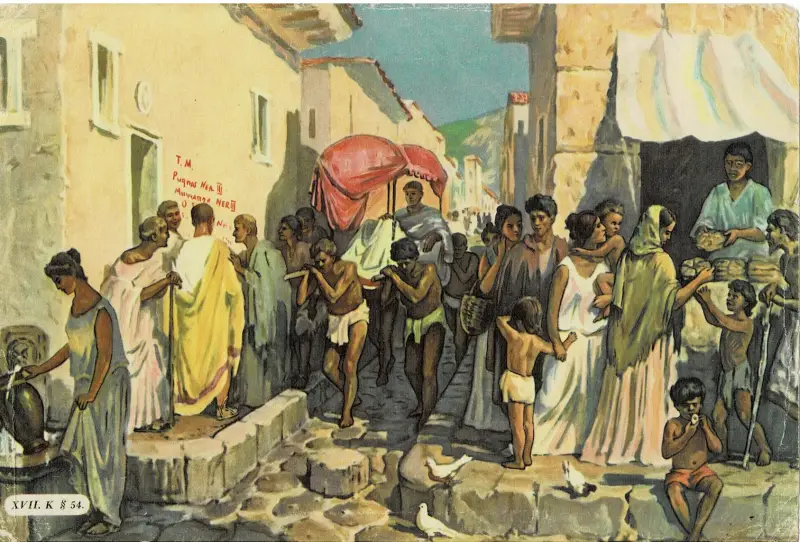
Street of a Roman city. Illustration from a Soviet textbook stories The ancient world for 5th grade. At one time I could look at them... well, for a very long time
fenced with a wall,
then you can buy it
before the expiration of a year from its sale:
You can buy it back within a year.
Leviticus 25:29
People and history. Today the goal of our “expedition” is to visit a typical multi-story building... from the era of the Roman Empire. Let's forget for a while about the wonders of Ancient Egypt and jump over a couple of millennia at once. Why is that? Yes, simply because the author has just finished another visual aid for history lessons at school and he just can’t wait to talk about it, and show it too.
Naturally, accompanying photographs of what happened with a corresponding story. But it turned out to be a real Roman insula, and for the Romans, quite wealthy.
Of course, it would be ridiculous to urge VO readers to make the same one and also give it to their home school (or give it to their child as a toy!), but why not. So here and now there will be a story about Roman houses, and a brief description of the technology for making a model of such a house.
Well, let's start with the fact that the best Roman houses, like temples, were copies of Greek models. But in the beginning everything was completely different. The dwellings of the first shepherds of the era of Romulus and Remus, who lived on the seven hills, were something like a hut with one room. There was a hole in the ceiling of such a hut that served as a chimney. But over time, people, having become rich, could add a room or two to such a hut.
The new houses of Roman citizens followed the same pattern. The room “with a hole in the ceiling” was transformed into something like a ceremonial hall - it was called the “atrium”. Below the hole in the roof was a shallow gutter to collect rainwater. Moreover, the principle of collecting rainwater was followed even in more prosperous times. The houses of the Roman rich still had an atrium and a water tank. Several rooms also opened into the atrium - mainly bedrooms.
On the far side there were living rooms, and behind them a small garden, which could have statues (brought from plundered Greece or copies of them!) and a fountain. The garden was surrounded by a covered colonnade. The kitchen and dining room were located so that you could admire the fountain while eating. Whenever possible, we also tried to build a bathroom.
The walls, covered with plaster, were decorated with paintings - usually scenes from rural life, including images of birds and flowers. Bright colors harmonized with the various shades of the mosaic floor. Moreover, the Romans were very fond of mosaic floors and even in not very rich houses they laid them out of multi-colored pebbles!
A very large house in Rome could occupy the entire space bounded by four streets, thereby forming an entire block, or "insula" ("island"), as the Romans called it. Partly for additional income, and partly to protect the family from the noise and bustle of the street, some parts of the house facing the street were rented out to shopkeepers and had separate entrances.

Roman one-story insula for an entire block...
There could even be a slave sitting at the front door, preventing uninvited visitors from entering the house. Also, a watchdog was sometimes tied near the entrance to protect the house from thieves. A door was found in Pompeii with a mosaic image of a dog and the words Save Canem (“Caution! Dog”).
But such rich houses were rare even in Rome. Most of the townspeople were poor, and the only affordable housing for them in the capital remained apartment buildings. There was not enough land for construction, and homeowners could increase their living space only by adding new floors to the buildings. Since greedy owners often used unsuitable materials during construction, the risk of collapse increased with the height of the buildings.
Because of this, many Roman emperors issued laws limiting the height of apartment buildings to a certain size, for example, 17–20 meters. But even at this height, the building could have eight or nine floors. The more floors there were, the more residents could be squeezed into such a house, and the higher the profit for the homeowner.

Insula with interior views. Such drawings of Roman houses are found in many educational publications, and they are very visual
But in general, the level of construction skills of the Romans was very high. The walls were made of either burnt bricks and stone, although sun-dried bricks were used. Usually two walls were laid out, and the space between them was filled with broken stone and gravel, which were poured with cement, thus obtaining “Roman concrete.”
The thickness of such walls reached 60 cm and... many of them have survived to this day. And then the same technology for masonry walls migrated to the Middle Ages, where the walls and towers of knightly castles were built using exactly this method.
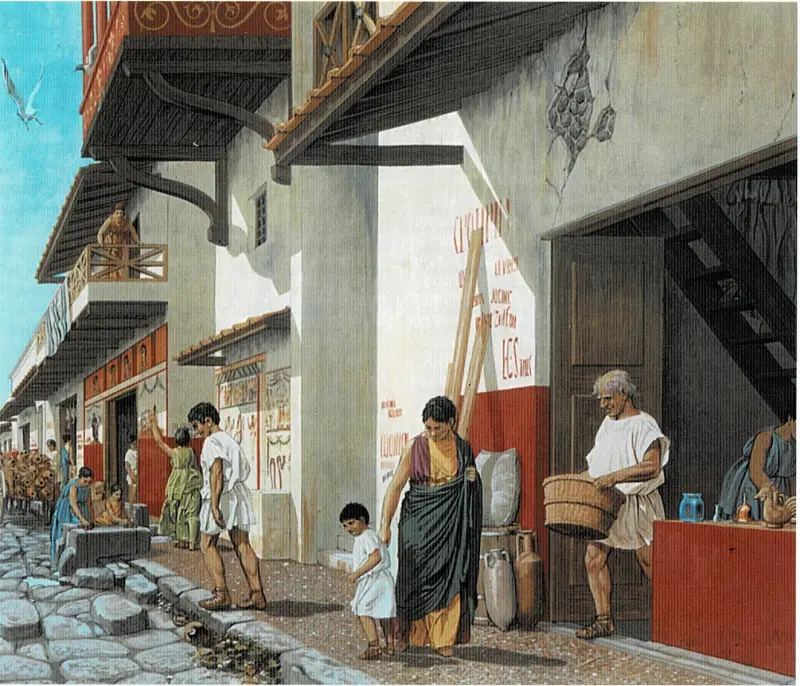
Street and shops
The Romans, of course, did not know elevators. Or rather, they knew, but did not use them. Except that in Nero’s “Golden House” he had an elevator powered by slaves. Poor people could not afford expensive glass windows. Although the Romans knew glass, they even knew how to make window glass.
However, in the hot and stuffy Roman summer they were not really needed, but when the weather worsened, the residents could only close the windows with wooden shutters so that the cold and streams of rain did not penetrate into the apartment.
Since the room was plunged into darkness, the residents had to light smelly lamps fueled with olive oil. For heating, portable metal braziers were used, in which charcoal burned. Rich people enjoyed a safer and more efficient system. A hypocaust was built under the main rooms, into which hot air came from an external firebox, heating the floor.
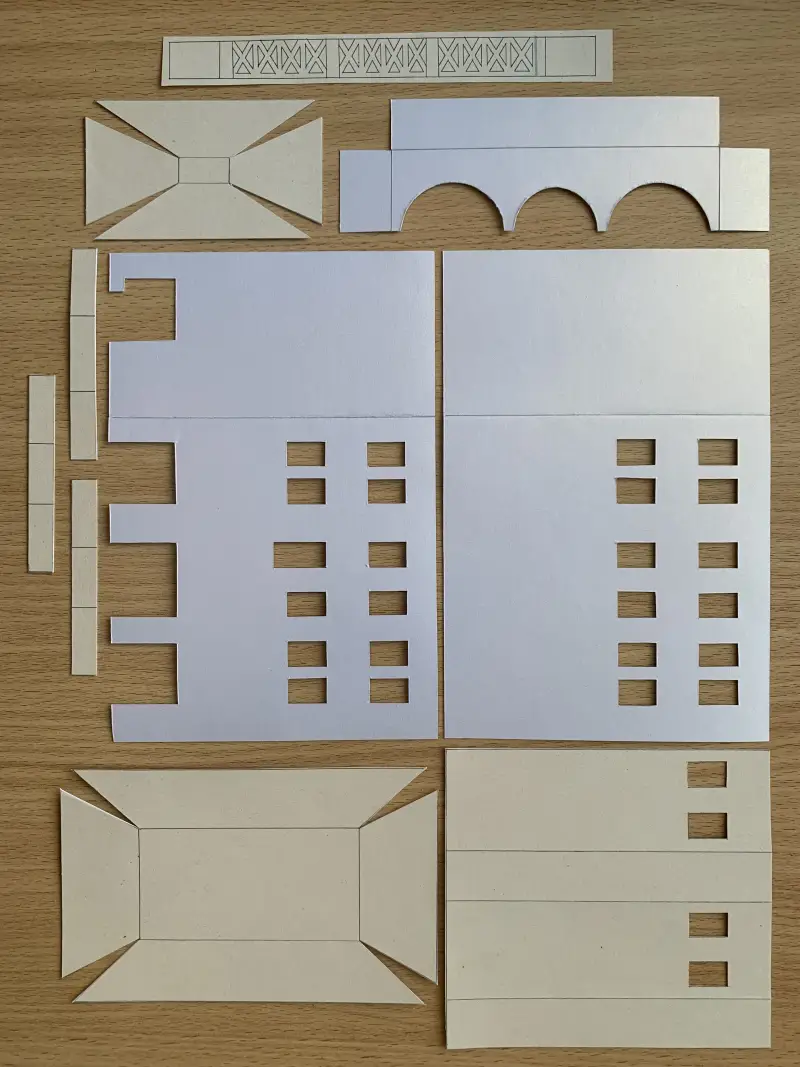
Making a model of a small three-story insula is not difficult. Here are the scans for such a layout on a scale of 1:100. Material: thick paper. You just need to remember that the rectangles in the central part of the roof parts will need to be cut out, and these parts themselves will need to be glued end to end. Otherwise, a roof with a skylight in the outline will not work
In apartment buildings, braziers and lamps often caused fires, which were extremely dangerous, since many buildings were built mainly from wood. It wasn't just the apartment where the fryer tipped over that was at risk: the flames could have engulfed an entire block. If this happened, there was almost no way to save the house. Under the emperors, firemen appeared in Rome, but they had neither hoses nor mechanical pumps.
All they could do was form a human chain and pass leather buckets of water from hand to hand in the hope of getting the water to the burning block quickly enough to put out the fire. If this failed, the building was broken down with hooks tied to long poles to prevent the spread of fire.

Now you can order a set with tile roof details in any scale online. But... it seemed to me that such roofs looked very toy-like, and I decided to make the roof homemade and extremely cheap. And he did it by cutting coffee stirrer sticks into pieces. True, their scale turned out to be greater than 1:100, but for a layout - a visual aid - absolute accuracy in all details does not matter. Some convention is quite permissible
There was no running water in the Roman quarters. That is, again, it was there, but it supplied water only to street fountains and “drinking bowls.” Residents had to bring all the water they needed to their apartments, which, of course, were not equipped with any latrines, and the townspeople considered themselves very lucky if there was a public urinal next to their house!
In Rome, sewage was carried out onto dung heaps, into cesspools, or... simply thrown out of the windows. The Roman satirical writer and speaker Juvenal mentions accidents that await a passerby walking past the windows of a multi-story building: “broken dishes fly from above; it’s good if they just throw out the voluminous tub.”
For residents, by the way, this was a convenient way to quickly empty the contents of their chamber pots, especially since the streets were cleaned by slaves, who swept and washed away all the garbage and waste from the paved streets into street sewers with running water. True, sometimes tanners left special amphorae near houses to collect urine. For Roman men living in poor houses, this was a great boon!
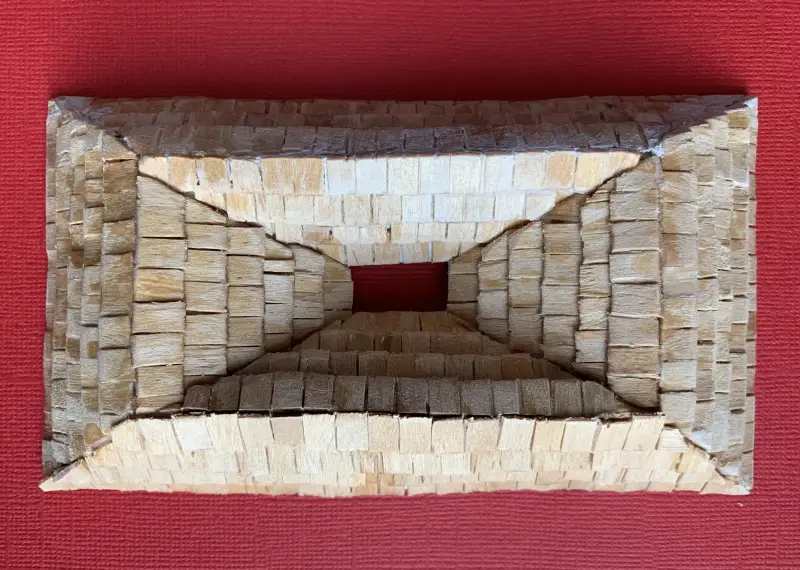
The assembled roof before painting. All the “tiles” are glued with PVA glue and, one by one, in strips, pressed to the base with clothespins!
On the ground floors of the houses there were also numerous specialized shops of merchants. They could stretch in rows along the street or along the sides of the square. Shops were also sometimes located in one or another corner of a rich man's land or in a residential area.
At night, the shops were closed with wooden shutters, which were swung wide open during trading hours. Very often, goods intended for sale were made directly in the workshop behind the shop. The artisan's wife and adult children traded, and the whole family lived on the second floor or in an apartment behind the workshop.
Transporting goods was expensive. Therefore, local artisans made their products from local materials and according to local designs. You would be hard-pressed to find a piece of fabric with your favorite pattern in any city other than your own. Apparently, only some ceramic products were produced in large quantities and exported.
Male slaves were sent to the shops in the forum (market square) for shopping. Women, especially rich ones, almost never walked around the shops; they only bought cosmetics, fabrics and jewelry.
The stalls at the markets sold meat, fish, vegetables and fruits. The fish was offered to the buyer, probably in dried form - lovers of fresh fish went to a special shop for it, where they could choose live fish in a tank with water. Other shops sold shoes, knives, hardware, ropes, leather goods, poultry, wine, bread and much more. In Rome, as in any large modern city, you could buy almost everything.
In Roman cities, a service unknown to us was provided for money - a public center. Since residents of apartment buildings had no place to cook food, the baker rented out his hearths. The poor brought him their lunch, and the baker, for a small fee, cooked it on this hearth.
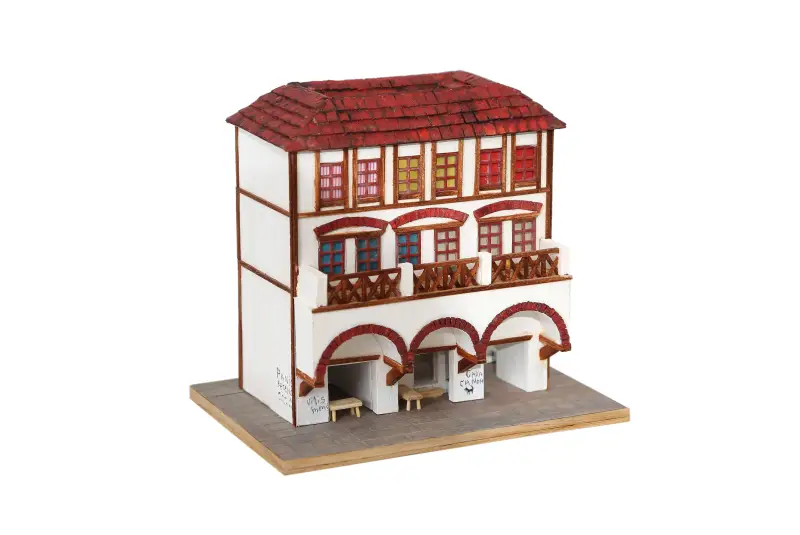
The model is fully assembled and painted with acrylic paints. Since the house is for wealthy Romans, all the windows and the balcony door have frames and “glazing.” On the model they are printed on a 3D printer. But in a house for the poorer, you can not make them, but close them with shutters made of stirrer sticks and “curtains” made of colored paper. There are two shops on the ground floor of the house. The first is a bread room, on the side wall there is a Latin inscription “Fresh Bread”. Another shop is near the entrance. On the wall there is also written “Caution. Dog" and a dog with a curved tail is drawn. Balcony fencing made of 2 mm thick slats from SV Model
Outside, on permanent benches, they often wrote what they sell here or what service they provide, for example, “Butter,” “Books,” “Shoe Repair,” or “Barber.” However, it was not customary to write the owner's name. In the case where there were no inscriptions, the owner of the shop probably used a conventional sign, for example, tavern keepers decorated the doors with green branches.
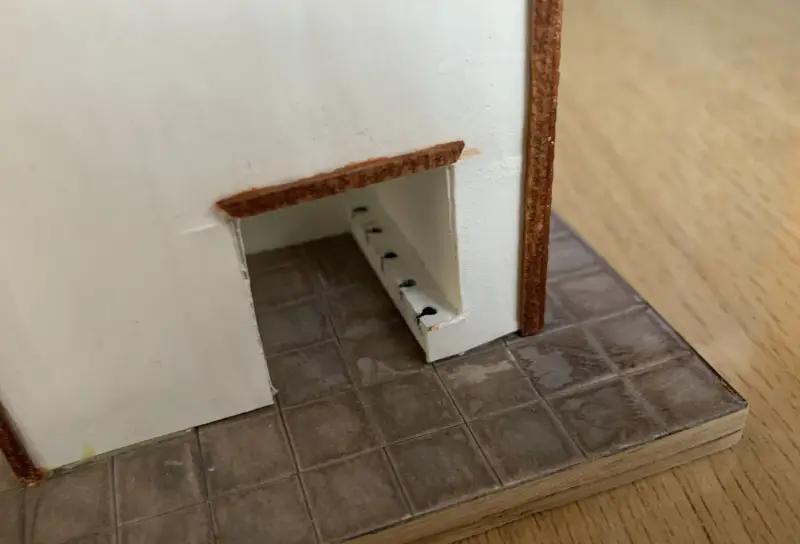
The next doorway "behind the dog" leads to a public toilet with typical Roman urinals! So the residents of this house are especially lucky!
Shops existed even in the smallest Roman cities. Several years ago, during excavations carried out in the English city of St. Albans, archaeologists found the foundations of shopping arcades near an open Roman theater. With a little imagination, you can imagine how slaves bought olive oil, wine or ready-made meals from clerks or seller's assistants for their masters and paid with bronze coins, being on the farthest outskirts of the empire.
Information